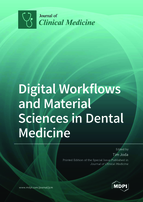Digital Workflows and Material Sciences in Dental Medicine
A special issue of Journal of Clinical Medicine (ISSN 2077-0383). This special issue belongs to the section "Dentistry, Oral Surgery and Oral Medicine".
Deadline for manuscript submissions: closed (31 May 2021) | Viewed by 74796
Special Issue Editor
Interests: reconstructive dentistry; prosthodontics; implant dentistry; digital technology; dental materials; augmented/virtual reality; artificial intelligence; big data & eHealth; public health; translational research
Special Issues, Collections and Topics in MDPI journals
Special Issue Information
Dear Colleagues,
The trend of digitalization is an omnipresent phenomenon today—in social life and in the dental community. Advancement in digital technology has fostered research into new dental materials for the use of these workflows, particularly in the field of prosthodontics and oral implantology.
CAD/CAM technology has been a game changer for the production of tooth-borne and implant-supported (monolithic) reconstructions: from optical scanning, to on-screen designing, and rapid prototyping using milling or 3D printing. In this context, the continuous development and speedy progress in digital workflows and dental materials ensure new opportunities in dentistry.
The objective of this Special Issue is to provide an update on the current knowledge with state-of-the-art theory and practical information on digital workflows to determine the uptake of technological innovations in dental materials science. In addition, emphasis is placed on identifying future research needs to manage the continuous increase in digitalization in combination with dental materials and to accomplish their clinical translation.
This Special Issue welcomes all types of studies and reviews considering the perspectives of the various stakeholders with regard to digital dentistry and dental materials.
Prof. Dr. Tim Joda
Guest Editor
Manuscript Submission Information
Manuscripts should be submitted online at www.mdpi.com by registering and logging in to this website. Once you are registered, click here to go to the submission form. Manuscripts can be submitted until the deadline. All submissions that pass pre-check are peer-reviewed. Accepted papers will be published continuously in the journal (as soon as accepted) and will be listed together on the special issue website. Research articles, review articles as well as short communications are invited. For planned papers, a title and short abstract (about 100 words) can be sent to the Editorial Office for announcement on this website.
Submitted manuscripts should not have been published previously, nor be under consideration for publication elsewhere (except conference proceedings papers). All manuscripts are thoroughly refereed through a single-blind peer-review process. A guide for authors and other relevant information for submission of manuscripts is available on the Instructions for Authors page. Journal of Clinical Medicine is an international peer-reviewed open access semimonthly journal published by MDPI.
Please visit the Instructions for Authors page before submitting a manuscript. The Article Processing Charge (APC) for publication in this open access journal is 2600 CHF (Swiss Francs). Submitted papers should be well formatted and use good English. Authors may use MDPI's English editing service prior to publication or during author revisions.
Keywords
- Dentistry
- Prosthodontics
- Implant dentistry
- Digital technology
- Dental materials
- Rapid prototyping
- CAD/CAM technology
- Optical scanning
- 3D printing
- Translational research







